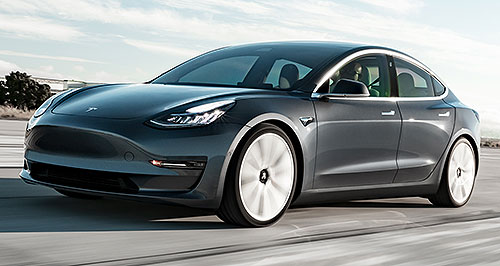Make / Model Search
News - Market Insight - Market Insight 2020Market Insight: True state of EV sales in Australia3 cheers: The first shipment of 2414 Model 3s took Tesla’s most affordable car straight to the top of the EV sales charts last year. Full-electric vehicle sales across all other brands combined totalled 1523 units. Tesla snares 2950 sales last year from total Australian EV/PHEV market of 5875 unitsGallery Click to see larger images 30 Jun 2020 By TERRY MARTIN THE most accurate picture of the state of the electric vehicle market in Australia emerged last week with official figures showing that 5875 full-electric and plug-in hybrid electric vehicles were sold in 2019, with half of these – 2950 units – representing Tesla EVs.
The figures were contained in the annual report on CO2 emissions from new light vehicles compiled by the National Transport Commission (NTC), which combines data supplied by the Federal Chamber of Automotive Industries (FCAI) with new vehicle registrations from individual states and territories, the latter identifying Tesla sales which are not recorded under the FCAI’s VFACTS reporting system.
Tesla’s 2950 sales last year represented a 194 per cent increase on the 1005 units delivered to customers in 2018, and the rising tide reflects long-awaited shipments of the Tesla Model 3 mid-size sedan.
As GoAuto reported last year, 2414 examples of the Model 3 were identified as having berthed in Australia last August, more than two years after production started in the US.
The subsequent flood of registrations as customers in Australia finally took delivery of Tesla’s smallest and most affordable model sent the Model 3 straight to the top of the charts as the biggest-selling electric car in the country.
In comparison, the total number of full-electric vehicle sales last year from all other makes and models combined, as recorded by the FCAI, was 1523 – around 1400 fewer than Tesla managed across its full range but nonetheless a huge 706 per cent upswing from the 189 sold the previous year.
Moreover, 1402 PHEV sales were also made, a rise of 21 per cent (239 units).
Combined EV/PHEV sales of 2925 units across all brands (ex-Tesla) therefore represented a 116 per cent increase on 2018, while the total 5875 market with Tesla sales included marked a 149 per cent increase overall.
It is a positive result from every angle, but considering 1,027,848 light vehicles were sold in Australia last year – covering passenger cars, SUVs and light-commercial vehicles (including the Tesla figures) – electric vehicles still only accounted for a tiny 0.57 per cent of the market.
In terms of cumulative sales, the NTC also used Australian Bureau of Statistics (ABS) data to calculate that approximately 14,500 EVs and PHEVs were in the Australian vehicle fleet at the end of last year, quietly running around on our roads that as at January 31, 2019, were carrying 17.8 million light vehicles.
That sees electric vehicles equating to 0.08 per cent of the national car parc, not including heavy commercial vehicles.
Total Tesla registrations across Australia as at December 18, 2019, were at 6158 units, most of which were in New South Wales (2355), Victoria (1868) and Queensland (1167). The rest were split across Western Australia (317), the Australian Capital Territory (202), South Australia (182), Tasmania (57) and the Northern Territory (10).
For the remainder of the industry, total electric vehicle sales from 2010 to 2019 stood at 8569, with Victoria leading the way (2325), just ahead of NSW (2272) and with supporting roles played by SA (1605) and Queensland (1249).
Taking last year alone among the brands under the FCAI umbrella, NSW (832) and Victoria (815) were evenly matched as the leading states for EV sales, followed by Queensland (450) and SA (412).
While the premium Tesla Model 3 – which is priced from $66,000 plus on-road costs, up to $91,200 – clearly dominated the EV model rankings last year with more than 2400 sales, the FCAI data shows that among all other brands the well-established Mitsubishi Outlander PHEV was the clear favourite with 700 units, followed by Hyundai’s Kona Electric (499) and Ioniq BEV/PHEV models (475).
Nissan sold 408 examples of the new-generation Leaf that launched mid-year and Porsche delivered an impressive 269 examples of its high-performance plug-in Cayenne Turbo S E-Hybrid that arrived in both coupe and wagon guise in the final quarter priced from $288,000 and $292,700 plus on-road costs respectively.
The only other model above 100 units last year was the Jaguar I-Pace, at 155.
Breaking the FCAI sales down into buyer type shows that the vast majority of EV/PHEV purchasers were, perhaps surprisingly, private individuals (1293), with company capitalisations the next highest but well behind at 518 units, followed by dealer demonstrators (456), large fleet (215), other fleets (146) and the three tiers of government: local (136), state (123) and, a long way back, federal (16).  Read more6th of January 2020  VFACTS: Car industry takes big hit in 2019Hefty 7.8 per cent new-car sales downturn reflects ‘tough year’ for Australia: FCAI2nd of October 2019  Tesla Model 3 sales dwarf all other EVsMore than 2400 deliveries and counting for Tesla’s Model 3 in Australia since August30th of August 2019  Australia’s car CO2 emissions remain highMild 0.4 per cent fall in vehicle emissions in 2018 as SUV, ute love affair rolls on13th of August 2019  Potent Porsche Cayenne plug-in hybrid arrivesPorsche Cayenne Turbo S E-Hybrid pair heads Down Under from $288,000 plus ORC23rd of July 2019  Tesla brings 620km Model 3 Long Range to OzAustralian Tesla Model 3 line-up gains Long Range variant claiming 620km on a charge |
Click to shareMarket Insight articlesResearch Market Insight Motor industry news |












Facebook Twitter Instagram